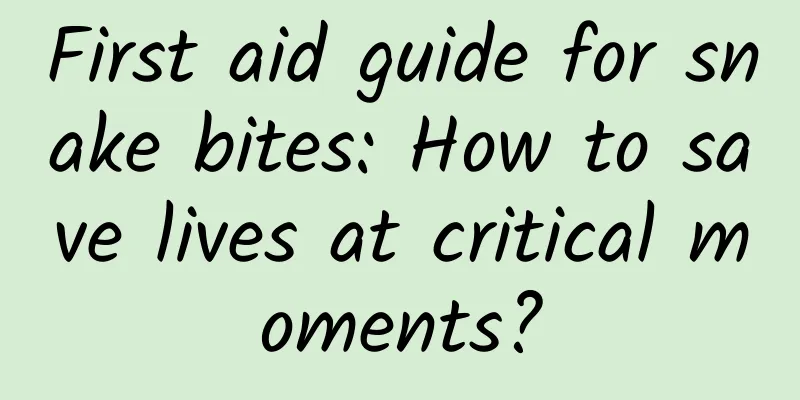First aid guide for snake bites: How to save lives at critical moments?

|
Author: Lv Chuanzhu, Professor and Chief Physician, Sichuan Academy of Medical Sciences and Sichuan Provincial People's Hospital Yan Shijiao, Professor of Hainan Medical University Deng Xiaoxu, Associate Researcher, Science and Technology Literature Publishing House Reviewer: Zhu Huadong, Professor and Chief Physician, Peking Union Medical College Hospital Every summer, venomous snake bites occur frequently, especially in southern my country. According to statistics, there are about 250,000 to 280,000 venomous snake bites in my country each year. The most common body parts bitten are the feet, ankles and calves, accounting for about 56%, followed by the hands, forearms and upper arms. Severe cases may lead to disability or even death. In the face of this sudden danger, it is crucial to master scientific first aid knowledge. Figure 1 Original copyright image, no permission to reprint 1. Learn to identify poisonous snake bites first 1. Common "dangerous elements" Cobra and Bungarus regulus: They release "neurotoxic poison" which can cause muscle numbness, breathing difficulties and even suffocation after being bitten! Pit viper and pit viper: release "blood poison", causing wounds to bleed profusely, and internal organs may also bleed! Chinese cobra: releases "cytotoxicity", the wound is so painful that it bursts, swells up like a steamed bun, and the flesh may rot! 2. 2. How to determine whether it is poisoning? Look at the tooth marks: The bite marks of venomous snakes usually have 1 to 2 pairs of obvious "big tooth marks", while the bite marks of non-venomous snakes are fine and small tooth marks. Look at the symptoms: If swelling quickly occurs, dizziness, vomiting, and difficulty breathing after being bitten, it is likely that the person is poisoned. Beware of "dry bites": About 20% of venomous snake bites may not release toxins, but must be observed for 24 hours! 2. The Golden Rules of First Aid: 5 Dos and 5 Don’ts 1. Five steps to save your life: Stay calm and don’t panic: an accelerated heartbeat will speed up the spread of toxins. Get away quickly: avoid the snake's second attack. Fix the injured limb: Use branches or clothes to fix it and keep the wound below the heart. Take off jewelry: to prevent swelling and strangulation of the affected area. Call for help immediately: Dial 120 and go straight to the hospital with anti-snake venom serum! Figure 2 Original copyright image, no permission to reprint 2.5 Major taboos: Don't cut the wound (it will increase bleeding or infection)! Don’t take drugs with your mouth (it will harm others and yourself)! Don't apply ice or fire (accelerates necrosis)! Don’t drink alcohol or coffee (it speeds up the absorption of toxins)! Don't tie up the affected limb yourself! Figure 3 Original copyright image, no permission to reprint 3. Anti-venom serum: the only "antidote" 1. Why is serum necessary? Serum can neutralize toxins and is the key to saving lives! 2. Medication principles: fast, accurate, and sufficient Golden 1 hour: The best time to take medication is 1 to 2 hours after being bitten. If you delay for too long, irreversible organ damage may occur. The dosage for children does not decrease: children have less blood and higher toxin concentration, so the dosage is the same as that for adults! If symptoms worsen, add more medicine: if there is no improvement after 6 hours, additional serum is needed. 3. Beware of allergy risks A skin test is required before using the medication, but if the situation is critical, the doctor will take the risk of using the medication under supervision and have epinephrine ready for emergency use. Figure 4 Original copyright image, no permission to reprint IV. Hospital treatment: the key to preventing sequelae 1. Wound treatment: The doctor will clean the necrotic tissue but will never cut the wound randomly. 2. Symptomatic support: Coagulation disorder: plasma transfusion (first give enough serum); respiratory paralysis: intubation and mechanical ventilation; infection prevention: use cephalosporin antibiotics. 3. Tetanus shot: Leave at least 1 hour between the shot and serum. 5. Prevent snake bites: Remember these points 1. Outdoor activities: wear long pants and high-top shoes, and don’t flip rocks with your bare hands! 2. Snakes’ active period (April to October): Avoid going to bushes at night and use flashlights for lighting. 3. When encountering a snake: slowly step back 2 meters and don’t provoke it! 4. Prevent snakes from entering your home: clear weeds and block wall cracks and drains. Figure 5 Original copyright image, no permission to reprint In the end, a snake bite is a race against death. Remember the eight-character strategy: stay calm, stop, seek medical attention, and fight the poison! Forward this to your family and friends. The more people know, the less tragedy there will be! |
<<: The patient says he is “not sensitive to anesthetics”, what should I do?
Recommend
Can I masturbate on the ninth day after abortion?
After an abortion, women need to pay attention to...
Is the ostrich a protected animal? What does the ostrich eat?
African ostriches live in the desert grasslands a...
Can I eat sweet potato leaves during breastfeeding?
Sweet potato leaves are what we often call sweet ...
What are the causes and hazards of high blood uric acid in women?
If you have high blood uric acid in your daily li...
What is the best way to treat dysmenorrhea?
I believe that all women are familiar with dysmen...
Wu Anhua and Gao Wei from the First Affiliated Hospital of China Medical University: Standardizing the diagnosis and treatment of pituitary tumors, doctors and patients work together to avoid "tumor" regrets
The pituitary gland is located on the ventral sid...
How long does a colposcopy take?
The structure of a woman's reproductive syste...
What is the reason for high bacteria in pregnant women's urine routine test
Pregnant women must pay attention to the examinat...
What is the knowledge about weight loss for women?
Every woman pays great attention to her figure an...
Can I take amoxicillin while pregnant?
Antiviral drugs are actually a common type of med...
What are the natural conditions for growing tea? What soil is most suitable for growing tea?
Tea is a traditional drink with a long history in...
Will sudden death be passed on to daughters? What are the signs before sudden death?
Sudden death, or sudden death, is occurring more ...
Explanation on back pain after miscarriage
Some women choose to have an abortion when they f...
Why take aspirin to protect pregnancy
During pregnancy, I believe no one wants the chil...
What to do if you feel itchy after your period
Menstruation is a process that every adolescent o...









